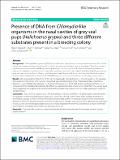Files in this item
Presence of DNA from Chlamydia-like organisms in the nasal cavities of grey seal pups (Halichoerus grypus) and three different substrates present in a breeding colony
Item metadata
| dc.contributor.author | Dagleish, Mark P. | |
| dc.contributor.author | Flockhart, Allen F. | |
| dc.contributor.author | Baily, Johanna L. | |
| dc.contributor.author | Hall, Ailsa J. | |
| dc.contributor.author | Simpson, T. Ian | |
| dc.contributor.author | Longbottom, David | |
| dc.date.accessioned | 2021-10-14T14:30:05Z | |
| dc.date.available | 2021-10-14T14:30:05Z | |
| dc.date.issued | 2021-10-13 | |
| dc.identifier | 276279420 | |
| dc.identifier | 70df51ed-ae6d-44ac-902d-85ce89846d17 | |
| dc.identifier | 85117302995 | |
| dc.identifier | 000707005500002 | |
| dc.identifier.citation | Dagleish , M P , Flockhart , A F , Baily , J L , Hall , A J , Simpson , T I & Longbottom , D 2021 , ' Presence of DNA from Chlamydia -like organisms in the nasal cavities of grey seal pups ( Halichoerus grypus ) and three different substrates present in a breeding colony ' , BMC Veterinary Research , vol. 17 , 328 . https://doi.org/10.1186/s12917-021-03032-3 | en |
| dc.identifier.issn | 1746-6148 | |
| dc.identifier.other | RIS: urn:A96AA7EDA4A12B364E64C53E028F2F3F | |
| dc.identifier.other | RIS: Dagleish2021 | |
| dc.identifier.other | ORCID: /0000-0002-7562-1771/work/101581495 | |
| dc.identifier.uri | https://hdl.handle.net/10023/24139 | |
| dc.description | This work was supported by the Biotechnology and Biological Sciences Research Council/Zoetis [grant number BB/J015083/1]; the Rural and Environment Science and Analytical Services (RESAS) division of the Scottish Government; and the Royal Zoological Society of Scotland. | en |
| dc.description.abstract | Background: Chlamydia-like organisms (CLO) have been found to be present in many environmental niches, including human sewage and agricultural run-off, as well as in a number of aquatic species worldwide. Therefore, monitoring their presence in sentinel wildlife species may be useful in assessing the wider health of marine food webs in response to habitat loss, pollution and disease. We used nasal swabs from live (n = 42) and dead (n = 50) pre-weaned grey seal pups and samples of differing natal substrates (n = 8) from an off-shore island devoid of livestock and permanent human habitation to determine if CLO DNA is present in these mammals and to identify possible sources. Results: We recovered CLO DNA from 32/92 (34.7%) nasal swabs from both live (n = 17) and dead (n = 15) seal pups that clustered most closely with currently recognised species belonging to three chlamydial families: Parachlamydiaceae (n = 22), Rhabdochlamydiaceae (n = 6), and Simkaniaceae (n = 3). All DNA positive sediment samples (n = 7) clustered with the Rhabdochlamydiaceae. No difference was found in rates of recovery of CLO DNA in live versus dead pups suggesting the organisms are commensal but their potential as opportunistic secondary pathogens could not be determined. Conclusion: This is the first report of CLO DNA being found in marine mammals. This identification warrants further investigation in other seal populations around the coast of the UK and in other areas of the world to determine if this finding is unique or more common than shown by this data. Further investigation would also be warranted to determine if they are present as purely commensal organisms or whether they could also be opportunistic pathogens in seals, as well as to investigate possible sources of origin, including whether they originated as a result of anthropogenic impacts, including human waste and agricultural run-off. | |
| dc.format.extent | 7 | |
| dc.format.extent | 1736354 | |
| dc.language.iso | eng | |
| dc.relation.ispartof | BMC Veterinary Research | en |
| dc.subject | Chlamydia-like organisms | en |
| dc.subject | Parachlamydiaeae | en |
| dc.subject | Rhabdochlamydiaceae | en |
| dc.subject | Simkaniaceae | en |
| dc.subject | Sentinel species | en |
| dc.subject | Coastal reservoir | en |
| dc.subject | GC Oceanography | en |
| dc.subject | QR Microbiology | en |
| dc.subject | DAS | en |
| dc.subject | SDG 3 - Good Health and Well-being | en |
| dc.subject | SDG 14 - Life Below Water | en |
| dc.subject.lcc | GC | en |
| dc.subject.lcc | QR | en |
| dc.title | Presence of DNA from Chlamydia-like organisms in the nasal cavities of grey seal pups (Halichoerus grypus) and three different substrates present in a breeding colony | en |
| dc.type | Journal article | en |
| dc.contributor.sponsor | NERC | en |
| dc.contributor.institution | University of St Andrews. School of Biology | en |
| dc.contributor.institution | University of St Andrews. Sea Mammal Research Unit | en |
| dc.contributor.institution | University of St Andrews. Scottish Oceans Institute | en |
| dc.contributor.institution | University of St Andrews. Marine Alliance for Science & Technology Scotland | en |
| dc.identifier.doi | 10.1186/s12917-021-03032-3 | |
| dc.description.status | Peer reviewed | en |
| dc.identifier.grantnumber | NE/R015007/1 | en |
This item appears in the following Collection(s)
Items in the St Andrews Research Repository are protected by copyright, with all rights reserved, unless otherwise indicated.

